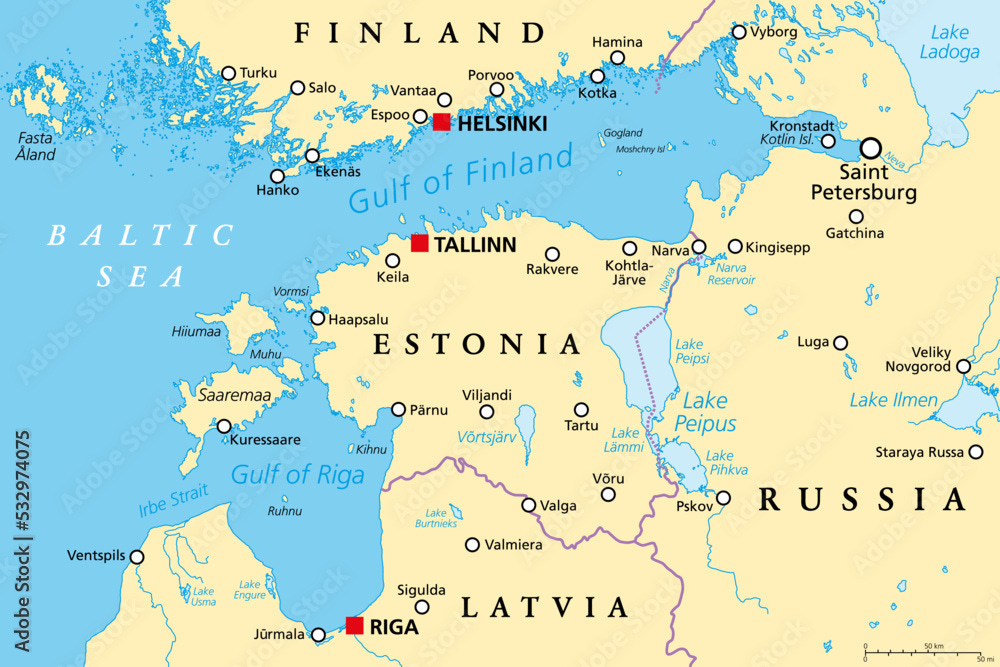What can we learn from Estonia? It’s not a question you hear often — the nation of under two million residents doesn’t mean much to many. But for good governance advocates, it’s long been a touchpoint for its “e-government” model. The New Yorker wrote in 2017 that, “apart from transfers of physical property, such as buying a house, all bureaucratic processes can be done online.” Wired called Estonia “the world's most digitally advanced society.” On its “e-Estonia” site, the country itself brags, in a mod font, “We have built a digital society, and we can show you how.”
The Estonian model has a lot going for it from the perspective of a citizen. For example: Taxes take a few minutes to file, you can see every time the government looks at your data, and you never have to give the government a piece of information more than once. And it makes governance easier: the bureaucracy is leaner, information is shared across agencies, and data is more secure.
But how much of this model could be adopted here in the US, or in the rest of the West? And how much is reliant on a cultural and societal context we just don’t have here? To get answers, I talked to Joel Burke, author of the new book Rebooting a Nation: The Incredible Rise of Estonia, E-Government and the Startup Revolution. Joel is an American who worked with the Estonian government, and I learned a lot from his book.
Joel, tell me about the historical context of Estonia’s e-government. Estonia gained independence from the Soviet Union in 1991. What was going on at the time?
If we roll back the clock to ’91, things were tough but hopeful. Estonia had been occupied for several decades by the Soviet Union, and had a long history of occupation by various regional powers.
The country was facing an economic conundrum. The Soviets were not that great at capitalism, and the factories and institutions they built were inefficient. Like every country that achieved independence from the Soviet Union, Estonia had to deal with economic reform. And Estonia decided to fully embrace the market economy. Mart Laar, who became Prime Minister, basically did economic shock therapy for the country, removing subsidies and the like. It was very aggressive.
A couple things set Estonia on a good trajectory. In many other post-Soviet places, factory operations were entrusted to their managers, with the intuitive idea that the people who had been running them knew best. But running a factory in the Soviet Union was a very political job and not focused on managerial efficiency. Estonia instead focused on finding foreign partners who could help reform these factories, make them more efficient, and co-invest. When they found that foreign direct investment, they tried to direct it toward digitizing their systems. Not digital as we think of it today — this was the early ’90s, we’re not talking about smartphones — but modernizing the underlying systems. This was most obvious in the banking sector. Many of the banks, even today, are from Sweden and other countries in the region. A big part of how they helped build the e-state was investing in online banking, which ended up fomenting the country’s digitization and adoption of technology.
You don't see that instinct toward modernization and digitization across the other former Soviet bloc countries. What's in the water that makes Estonia the edge case?
I’d say it’s what’s across the water — it’s Finland. Estonia is a short way away across a body of water from Helsinki. When Finland transmitted radio and TV waves, they were strong enough to reach from Helsinki to much of Estonia, including the capital. That meant that, unlike many of the nations cut off behind the Iron Curtain, Estonia still got exposure to the West, to a capitalist society a short distance away. You would read advertisements for grocery stores that were full of meat at a time when there were bread lines. Former President Ilves talks about watching reruns of Dallas and Dynasty and these ’70s and ’80s TV shows that were broadcast in English in Finland.
The other reason I mention Finland is, if we roll back the clock even further to just before Estonia was occupied in World War II, Estonia had about the same standard of living as Finland. Then after five decades of Soviet occupation, as you can imagine, Estonia far lags its neighbor in any calculation of wealth or wellness. So there was this sense of collegial rivalry or competitiveness, where Estonia and Finland were always each other’s measuring sticks. Or at least for Estonia, Finland was.
After receiving independence, Estonia saw that Finland was way ahead. It became clear that if they just followed the traditional development methods, they’d never be able to catch up. So they had to pursue a really radical agenda. And I think Estonians were bought into this idea of trying to leap across the chasm to make better lives for themselves, and both that popular support and the boldness of leaders allowed for really aggressive reform.
In your book, you talk about how Estonians really want to think of themselves as Nordic, rather than as a Baltic or Eastern European country.
One of my former colleagues, Adam Rang, was just talking about this. It does seem that Estonia is somewhat finding its groove; it’s no longer trying to be the Silicon Valley of Europe, or part of the Nordic nations. It’s like, “No, we’re Estonia, and we matter on our own.”
But when I worked for the Estonian government and led business development for the e-Residency program, it was definitely a key talking point we were supposed to get across. “No, no, Estonia is not Baltic. It’s Nordic.”
That's very funny. So Estonia achieved independence in ‘91, and there was a big privatization push, and export restrictions and price controls were abolished. One thing you flag is that even before the full digitization in 1993, there was a national commitment not to buy any legacy equipment, and instead build as much as possible internally or buy the cutting edge.
I think this is emblematic of principles that have become endemic to Estonian society, especially around the civil service and politics and startup culture — and there's a lot of mixing between those worlds. This idea of not purchasing or using legacy equipment was really important. It originated with either Sweden or Finland, which were major supporters of Estonia after independence, when the country desperately needed help. One of them offered to revamp the phone system in Tallinn. There was a choice between taking this free thing that’s old while this other country upgrades to a new system, or making sacrifices and building our own solutions and leapfrogging.
Estonia chose the latter. The country couldn’t just adopt the common model and grow slowly and work its way up the value chain. That doesn’t work for a country like Estonia, which is 1.3 million people and has no natural resources. It has to do really bold things.
This led to a realization that was maybe quite apparent at the time — if Estonia went to Microsoft or Oracle to get a quote for something, they actually couldn’t afford the big Western companies. They would have charged $20 million. This fomented a culture of domestic public-private partnerships to develop much of what would become the e-government digital infrastructure.
The e-IDs, for instance, were built with a consortium of the local banks to help facilitate access to online banking. Basically every e-service is built in partnership with a local tech company. That was initially a deliberate strategy to keep costs down, which came with the added benefit of helping to build up a domestic tech industry. That has turned into an export engine — and frankly, a branding engine — for the country.
You have a useful typology of the problems that e-government solves for Estonia in the late ‘90s. You flag three things: a lack of experienced bureaucrats, concern about the return of USSR-esque corruption, and inefficient service delivery. How did those factors play into the development of the e-government model?
In 1994 there was the “bloody autumn,” which was turf wars between gangs across the former Soviet Union. Estonia’s privileged trade position was part of the reason for its repeated occupation, and it had been part of the Hanseatic League long ago. If you've achieved re-independence after years of fighting for it and you're now in charge of your own destiny, you don’t want to fall into the trap of corruption. But if you don’t have the literal manpower to actually staff the system, what do you do? Estonia decided to bet on digitization.
Former President Ilves has a great quote: “You can’t bribe a computer.” That’s catching on elsewhere — one of Ukraine’s first big e-government projects was Prozorro open contracting, which has been held up as a gold standard. Government procurement contracts are a prime vector for corruption, so Prozorro puts things out in the daylight and digitizes them to protect the process. If you apply for a construction contract, you won’t have someone showing up at your house saying, “We can expedite this for a tip.” Instead, it goes through a standard digitized workflow and everyone can see who checked it.
Estonia is now making a big bet on AI too. If you're Poland or Ukraine, you're going to matter simply on the basis of your population and size. Without that, Estonia needed to find other ways to compete and make itself into an interesting market or have any meaningful impact on the global stage. Technology became that dual tool: a way to prevent corruption, and a way to compensate for a missing workforce while also solving pressing problems.
As you describe it, there are two key technologies to Estonia’s e-government: e-IDs, which are the digital identities, and X-Road, which is a secure data exchange layer. I could use a 101 on each of those.
Digital identity is how you verify who you are and authenticate that identity. Taxes are a classic example. I’m still mentally scarred from doing my US taxes a month ago. [NB: Last month, we spoke to Deputy Treasury Wally Adeyemo about efforts to improve the US tax filing process.] In Estonia, you go to the government website, which has many services, including the tax portal. When you land on the login page, you insert your digital ID card into a card reader connected to your computer and it prompts you for your identity code and an authentication PIN. This e-ID serves as the authenticator that lets individuals securely interact with the system, whether to access government services or add a digital signature. You can think of this as a much more secure version of using your email and a password, which were probably pwned long ago. On the other side, you’ve got the X-Road, which is the data layer that underpins it all and allows for distributed data exchange.
Estonia honors the once-only principle: if you’ve submitted your home address to one government agency, another agency shouldn’t have to ask you for it again. X-Road lets agencies share that information. I should also mention for your more technical audience that it’s now maintained by an open consortium, so other countries can explore and adopt it. If you want to go talk to the engineers, play with the code, and figure out how to build on it, you can.
These are the foundations of Estonia’s e-government and digital society, but I don’t think any other country should adopt the exact technologies or techniques Estonia used wholesale. Estonia should be looked to for its foundational lessons. When I worked for the Estonian government, I was sometimes brought out to speak with visiting American delegations. One common question was, “Can we just take Estonia in a box and copy it?” That doesn’t really work, nor should it.
I’m pretty skeptical that the US can implement digital identity at the federal level, given that REAL ID has taken 15 years just to update our driver’s licenses. But because we all have phones and most of them have biometric data, I do think we might see an interesting public-private partnership emerge to verify identity and link it to documents using Facebook or whatever.
I'm your non-technical audience here. Will you talk a little bit more about the X-Road and explain why it matters? What's the upshot for an Estonian citizen that there's a one secure data exchange layer?
I think the once-only principle is emblematic. Just imagine moving homes. Maybe you need to file your taxes, or your child needs to change schools. Instead of going through the slog of submitting the same information to multiple parties and maybe forgetting one, resulting in a letter being sent to your old address, or even moving countries and losing touch entirely, the system handles that. It sounds small, but these little things add up. X-Road enables seamless data sharing between agencies.
Some listeners might be screaming about privacy concerns here. Estonia’s system actually lets you look at all of the information the government has about you. For example, the government portal has a digital health record system. When I go to a doctor and they add a note or upload a lab result, I can log in and see exactly who has accessed my health records. If I notice that someone I didn’t authorize has viewed my data, outside of a few national security exceptions, I can demand that information from the government. The system enables transparency. It might not be directly privacy-preserving, but it creates an environment that facilitates it.
Compare that to the US with its caves and warehouses of paperwork. Most of us have no idea what information the government has about us, who’s accessed it, or how to find out. Maybe I could file a FOIA request, but I'm not even sure who I would send that to. That’s a crazy amount of work to put on an average citizen. In Estonia, the technical systems and strong rule-of-law culture enable a more accountable government.
This was surprising and counterintuitive to me. You’d think that data centralization and sharing is a privacy risk in Estonia, but it actually lets me access my data and understand how it’s being used.
In the current US model, I have no idea who in the federal government is poking around in my records, and there aren’t any checks on it that are visible to me. You can make privacy arguments in both directions.
I touched on this earlier, but a critical piece of this is that Estonia has a strong rule of law and low corruption. If you demand to know who accessed your data, the government will tell you, and you can trust that the data won’t be misused. I’d be much more concerned about centralizing large amounts of data in a country that didn’t have strong legal safeguards or real checks and balances. But Estonia has that rule of law and a strong press.
One of the advantages of being a country of 1.3 million people is local accountability. Maybe your parents went to school with the president, so they can message them on Facebook. Nothing grounds a person more than a message from an old teacher or favorite professor saying, “I don’t really like that thing you did.” It’s a much flatter hierarchy.
Say I'm a citizen of Estonia. What does all of this digitization cash out to?
At the government level, it's about efficiency. There are two sides to that coin: government time savings and citizen time savings. People can focus on things that are more worthwhile and productive. Not to put it in blunt economic terms, but it helps save money and grow the economy.
On the more individual side, take taxes, for example. Before I moved to Estonia, I was running a company in Germany for Rocket Internet, a private equity venture builder. I had filed taxes in the US, Germany, and Estonia in pretty quick succession. In Estonia, I simply went to the website, popped in my card, signed in, and everything was pre-populated. The government already knew how much I owed. I could review it and change a few fields if necessary, then press accept. It took roughly five minutes. I was a foreigner and it was my first time doing it: if I were more familiar with the system and tried to speed-run it, I could’ve done it even faster.
Now compare that to Germany, where you don’t even try to do your taxes yourself. That’s just not something a foreigner, and in some cases even a local, would do. I paid a Steuerberater, a tax lawyer, several thousand dollars. And then in the US, you have the privilege of paying a private company at least $100, if not more, to give the government information that it already has.
And that’s just one example. Think of every interaction you have with the government and imagine how a private company focused on maximizing efficiency or well-being would do it. I’m not saying Estonia’s perfect. It’s not. But there’s a customer-centric mindset that makes the government work for people instead of putting up barriers or using process as means-testing.
To your point about the benefits of government efficiency and bureaucracy-cutting, Estonia has the lowest debt-to-GDP ratio in Europe. That’s obviously not just a function of the raw size of the bureaucracy, but it points to the economic value of government efficiency.
In the book, you compare having a newborn in the US and getting that set of paperwork to having a newborn in Estonia. Will you share that example?
Let me caveat that this is research-driven — I haven’t had a kid in either place yet, so I don’t have personal experience.
In the US, you show up at the hospital with private insurance, or maybe you're on a public program like WIC. There are also many state and local programs that may or may not be relevant to your taxes and benefits, and you might not even know about them. When you have your child, maybe the hospital helps you with the registration. Then you receive a physical Social Security card and a birth certificate, which you might stash in a fireproof safe or bank deposit box.
In Estonia, you show up at the hospital, and after the baby is born, they get tagged to the parents’ digital identity. That sounds a bit funny, but that’s essentially what happens. Because the system has your information, if this is your third or fourth child, it triggers a tax benefit — Estonia, like many European countries, is dealing with low birth rates, so they’re trying to incentivize families to have more kids. Instead of you having to figure out which programs exist and how to apply for them, they just proactively sign you up, or send a message to check if you want this.
I think American listeners would agree that the equivalent American systems are way behind where they could be. Why don't we see more of this kind of digitalization in the US and the developed world more broadly?
There's no silver bullet here. but there are a few important factors I want to touch on.
First is timing. Estonia achieved independence at the dawn of the modern web, at least in a more commercial sense. And had the wherewithal to identify that trend and build on it. If it had been 20 years earlier, I don't know that they could have made the same bets. They might have ended up with an entirely different system. If you’re thinking about digitizing your country today, like the US is, you should not copy Estonia’s strategy, which used ‘90s technology. You should be thinking about how to use AI to reform systems.
Another element is culture. Estonia has created a civil service culture that rewards innovation. That’s exemplified by programs like Accelerate Estonia, which has a tagline of “Making illegal things legal.” The program solicits ideas for public good from private citizens and folks in the public sector and works to change the legal framework and partner with entrepreneurs to implement the proposals. And the people who helped build this program are lauded for it. One of the founders is now ambassador to the UK, which is a critical partner for Estonia. Folks like Siim Sikkut, the former CIO of Estonia, now runs Digital Nation and helps other countries build these systems.
In the US, we say that we want public servants to be more innovative, but having been on the congressional side, that’s not how things actually go. Say someone on the DoD procurement team does the right thing and says, “Instead of going with Lockheed Martin, we’re going to choose an unproven startup that has this amazing capability and give them a $500 million contract.” If that project goes belly up, there will be congressional hearings and people screaming about government waste. So instead of being applauded for trying something innovative, they’ll get yelled at. That incentivizes people to keep their heads down and just move up the ladder in a seniority-based institution.
I also think that we’re victims of our own success. Ditto for Germany and Japan, which are successful nations with crazy bureaucracies. The amount of paperwork you have to do in these places is absurd. But wealthy nations can paper over these problems, literally. We get trapped by not wanting to change the systems that led to our success — you don’t want to disrupt your own business.
In the book, I use the example of the Macy’s dilemma; they were a successful big-box retailer, synonymous with upscale fashion, and had the Macy’s Day Parade, but Macy’s is a shell of its former self because of fast fashion, Amazon, and all of the converging trends. I can sympathize with the executive team there at the dawn of Amazon. Do you blow up your business and bet on the web at a time when you don’t yet know if it will be successful? That's kind of a crazy thing to ask. That’s even harder to do at the national level where politicians are on two, four, or six-year cycles. In a wealthy country with a high quality of life like the US, that's tough to do.
That also applies to American state governance — the prettier, more lovely states like California get away with ridiculous mistakes in governance because they have this remarkable premium. The demand to exhibit good governance is much stronger in less pleasant states.
You’ve made clear that you can't just port over the Estonian model to the US. There are some obvious reasons for that, like scale and timing. Is federalism is another reason? We have 50 states, almost all of which are larger entities than Estonia itself. And then there’s a folk libertarianism and a distrust of centralized power in the US that I think is both a strength and weakness for us.
Given all of that, which parts of the Estonian model would be productive for American lawmakers and public sector servants to think about taking?
Prime Minister Laar — and many Estonian politicians — actually has a very libertarian bent. He was a great fan of Margaret Thatcher. And you’ll occasionally see articles about Estonia from the Heritage Foundation or Cato, so there’s been real cross-pollination between these groups. So despite — or because of — the push for e-government, there’s a libertarian sensibility. If you want a small but effective state, digitizing brings down the bloat and cuts the number of bureaucrats.
But there are a few core lessons that could be more broadly relevant. The first is doing unpopular things, even if they are politically difficult and costly. Take the economic shock therapy that Prime Minister Laar put the country to, for example. I'm paraphrasing here, but he later said something like, “If the people knew what we were going to do, they never would've elected us.” He knew that success required difficult economic circumstances — there were stories of government buildings not being heated because they didn’t have the money for it.
The second lesson is investing with a long-term perspective. The example I'd give here is the Tiger Leap campaign, which connected every school to the web. It sounds basic now, but in the 1990s, in a relatively poor country, that was huge, and helped close the digital divide. We’re still struggling with that in the US, but Estonia managed to achieve that two decades ago. It sounds intuitive to give kids access to the web and help them enter the workforce ready to take advantage of the internet economy. Meanwhile the teachers were underpaid and pensions were decimated because they were denominated in rubles. It was quite difficult politically, but Ilves and others put their political careers on the line to get it done.
Another key is bold leadership: being willing to do things that really matter, even if unpopular. One of the differentiating factors of Estonia’s implementation of digital identity was that it was mandatory from the outset. This was a bit controversial because it was relatively costly compared to the alternatives. People would joke that the only thing the card was good for was scraping ice off a windshield, because there were no services yet.
But because the government had made it mandatory, in Estonia’s small market, supermarkets, local banks, and transit agencies started to build on top of it. Your loyalty program is attached to your digital identity card, so you don't have to carry two things or enter your phone number. You also use it for the metro. Mass adoption encouraged bundling services with the card, which made it more useful.
I don't think that would've happened if it were opt-in and only 20% of the population used it. Because they were bold and took the long-term view, it worked. They also built consensus on digitization across political parties, so they were able to execute on the agenda across administrations.
You could argue that DOGE initially satisfied all three of those criteria. They’re certainly doing things that are short-term unpopular and bold, and trying to act very quickly. And pre-inauguration, there was widespread interest in DOGE on both sides of the aisle — House Democrats were signing up to join the DOGE caucus. The execution obviously looks different now, but how would you read the DOGE push in light of the Estonian experience? [NB: This interview was recorded at the end of May, before Elon Musk left DOGE.]
It’s a difficult question because the ground-truth information on what exactly is happening with DOGE is still somewhat limited. I’ll do a reverse shameless plug and recommend everyone read your piece on DOGE to get a firmer grasp of it. [Thank you, Joel.]
A key difference is that DOGE was not aligned with the bureaucracy. The small group of folks who built the post-independence government in Estonia were collaborative. DOGE didn’t bring everyone into the fold, even though, as you said, almost everyone would admit that there were problems with the system. I doubt anyone would say we're 100% efficient, so that was a missed opportunity. But I don’t want to backseat drive — it’s a really difficult project.
If I could pitch something to DOGE and the administration, it would be to focus on the bigger picture of creating an environment where government can thrive. I’ve seen through my interactions over the last few years with civil servants and folks on the political side in DC that most people are doing this for the right reasons. They’re patriotic and want to help their country. They’re just stuck in bad systems.
This will sound paradoxical, but I would start by making it much easier to fire people. There are low performers, and the current system incentivizes seniority and keeping your head down. It’s demoralizing to see someone who’s clearly incompetent get promoted just because they’ve been around longer. That kills morale.
Then, I’d make it way easier to hire people. Right now, if you want to bring someone on, it can take 6-12 months. You post the job on USAJobs, and the applicant has to figure out that fascinating website. I know it’s been improved, but it’s still not as simple as LinkedIn. Then you deal with all the hurdles and paperwork — there are tons of Office of the Inspector General (OIG) reports on this. We need to make it easier to hire and attract talent.
Once you’ve got really good people, you need to give them room to actually execute. We still need to see how things will play out post-Chevron, but speaking as a former congressional staffer, imagine trying to write a requirements doc for an e-tax system. Maybe someone could draft a bill with line-by-line instructions, but that’s a crazy way to do it. We should just define the outcome we want, and entrust the agency expert with delivering it. Congress should still provide oversight, but the most knowledgeable people should be the ones executing. I wouldn’t go to DOD and say, “Here’s how to fight a war.” That’s not a congressman’s job. The experts should make the day-to-day decisions.
Top performers enter the civil service to get things done, and getting trapped by paperwork and process drives them out. If you've got a job waiting for you back in the private sector that pays five times as much, that's an easy question.
To your point about the missed opportunity to bring people into the fold — I have to anonymize this, but someone who was pretty senior in a recent Democratic administration told me, “I'd love to lay out all of the places in my agency that DOGE could take a scalpel to and fix. But because of the political environment that DOGE has created, that would be seen as a total betrayal of former colleagues.” You might think this person should be braver, or agree that DOGE has created a toxic environment sourcing these issues and that you can't trust that they won't take a hatchet to the entire system. But in another context, I think they would've been happy to pass those criticisms to a Republican administration and tell them to tackle the issues.
One of Elon’s initial ideas for DOGE was to leverage AI and build integrated data systems. If you were at the helm of that, what would you tackle? Where would AI be useful?
I had a colleague who always said, “You have to do your homework before you can watch TV.” The idea here is that you need to fix the foundations of a system before building on top of it. Estonia built things like e-ID and X-Road, rather than introducing more kludge or workarounds.
With that in mind, my priorities would boil down to the American Dream: the house, the yard, the picket fence, the 2.5 kids, having a family and kids who have a better life than you did. IT comes down to healthcare, education, and housing. I’d love to use AI to look at where we can eliminate unnecessary rules in the permitting process. That’s probably one of the big levers, and I think some people are actively working on this.
This is a bit of a cop out, but I’d focus on the issues that affect people day to day and have the worst outcomes. For instance, the VA is essentially the largest healthcare provider in the US. I’d love to ask them what we can do to make their operations more efficient using AI. Maybe it’s scheduling automation, maybe freeing up doctor time. We should be targeting the thorniest problems.
Part of why I wrote the book is that I’m concerned that people are losing trust in government and institutions. They’re not delivering on what they promise, so I sympathize with someone who pays 40–50% in taxes and asks, “What did I actually get for this?” If the government could solve some of these problems, that would help rebuild trust.













